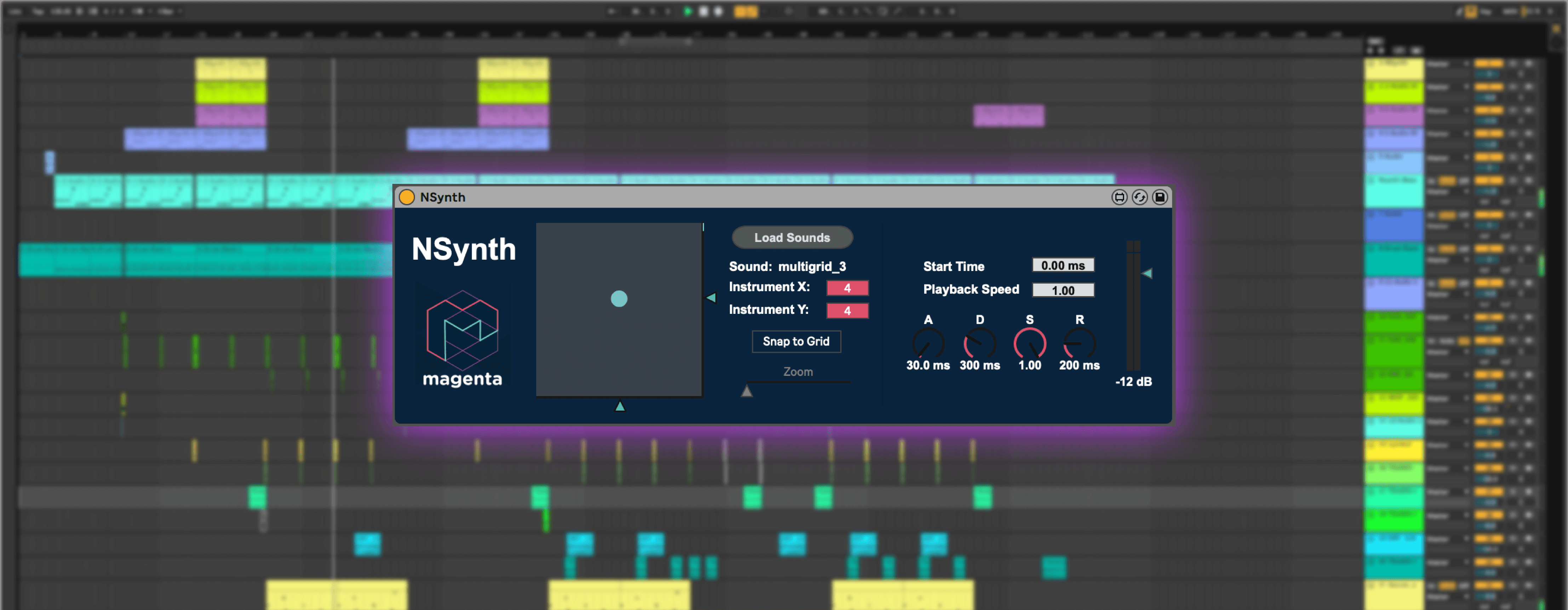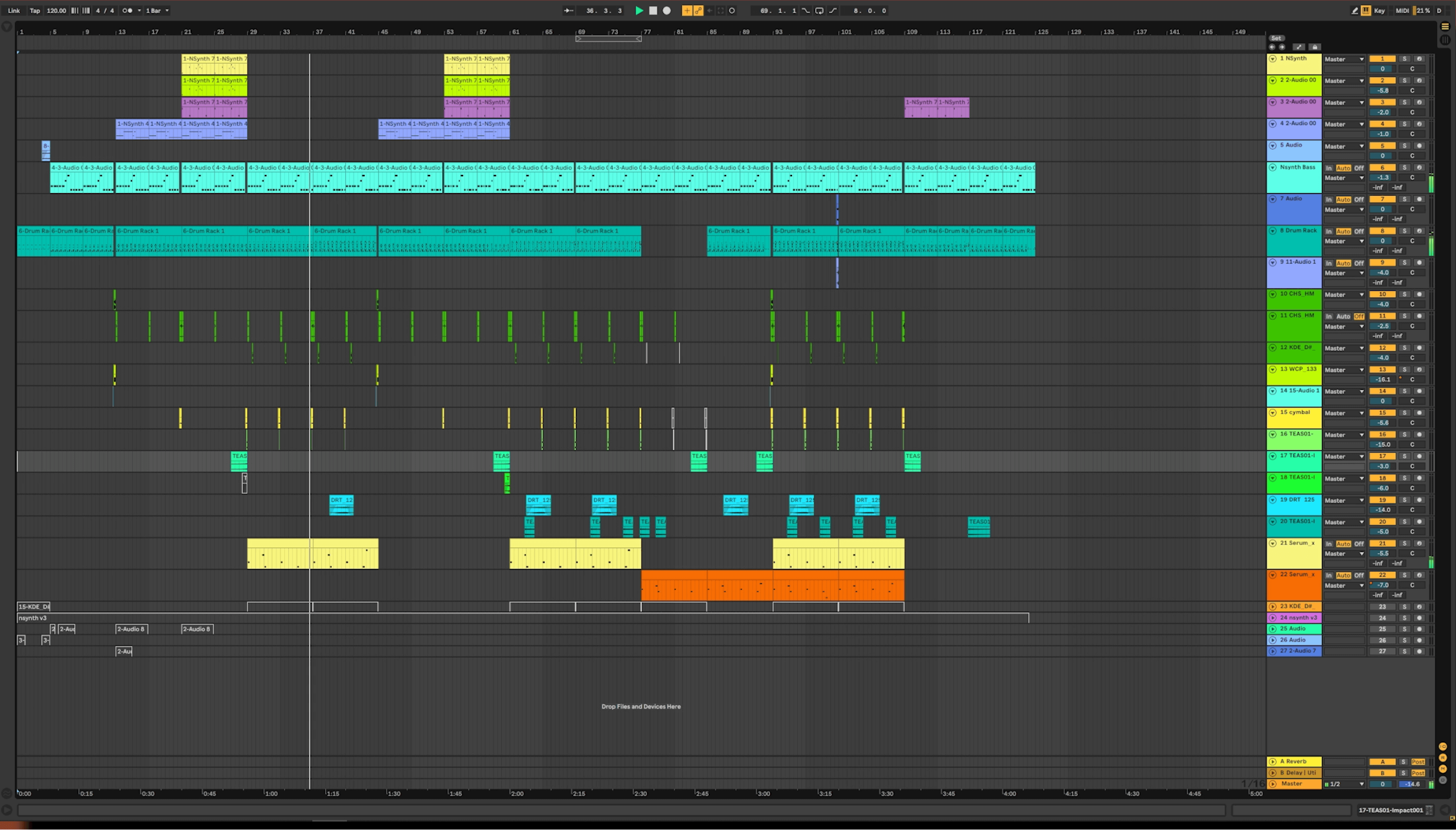

This blog post is a follow-up to our latest video on YouTube NSynth Ableton Live Instrument – Overview and Song, where we gave an overview of what NSynth is and showed a song that we made using the Ableton Live Instrument version of it.
ABOUT NSYNTH

NSynth is described as a neural synthesizer that uses “deep neural networks to generate sounds at the level of individual samples.” The NSynth Max for Live device features an X-Y grid with the ability to morph between instruments, snap to grid and zoom functions, start time, playback speed, and control over attack, decay, sustain, and release. You can load one of the pre-made grids or create a grid of your own which will require some extra knowledge and work.
THE TRACK

Drums
For the drums, I knew I would have to resample and edit a bit to get a desirable sound so I tweaked some of the pre-made NSynth grids until a couple of sounds with a nice transient were made. The sounds were resampled and used with Ableton’s sampler, Simpler. A lot of resonant low-pass and high-pass filtering was used to get the kicks, claps, and hi-hats to stand out a bit more and remove unneeded frequencies. I then experimented a bit by transposing each sound in the drum kit to taste to see which samples benefitted from it. Envelope filtering was then used to get the samples to sound more drum-like by shortening the sample length and creating more of an attack to make kicks sound more like kicks and claps sound more like claps. After a base was established with the resampled Nsynth sounds, layering of additional sounds from my sample library helped make things pop even more. Finally the drums were processed through parallel compression, parallel saturation, and parallel EQ to add more overall depth and focus.
Bass
For the bass, some time was spent experimenting and tweaking the different grids in NSynth until I got something I liked. The sound was recorded and sampled into Ableton’s Simpler so that I could further control and manipulate it. Once in simpler, I used high-pass filtering and envelope shaping to taste to see what sounded good. Once a desirable result was achieved, I then applied EQ for further shaping, compression to control the sound, chorus to widen and add depth, parallel saturation to stand out in the mix, side-chain compression to give it movement and groove, and an additional compressor to-taste.
Synth
The same process was used for the synths, tweaking and resampling one of the pre-made NSynth grids until a desirable result was created. Ableton’s simpler was only being used to play the samples to save resources and no editing was done with it. The main synth that you hear in the first part of the verse has a wide array of processing applied. A comb filter was experimented with to shape the sound into a more gritty electronic timbre, followed by compression for control, chorus for width and depth, and a large reverb to make it spacey. The synth that comes in during the second part of the chorus only has a large reverb applied to give it space.
Pad
To create the pads, I ended up using Xfer Records Serum instead of NSynth. Two different presets were chosen to use as a base for each pad. The pad in the first chorus is being processed with EQ to make the highs pop and remove some low end, chorus for width and depth, large reverb for space, compression for control, and sidechain compression to add some groove. The pad that comes in for the bridge and final chorus is being run through the same chain with additional saturation applied to add grit and a sort of lo-fi timbre.
FX
The FX consist of NSynth samples and samples from my library. I layered an impact with some of the claps and I also added reversed sounds every 8 bars in the verse and every 4 bars in the chorus with a few placed in other sections. The reversed sounds have changes in transposition and volume automation to make them fit the track better time-wise but no other processing applied. For the impact, only transposition adjustments and volume automation were used to control the timbre and decay of the sample.
CONCLUSION
NSynth is an interesting tool that I recommend checking out. I think it has potential for some unique sounds and I’m intrigued to hear what can be made from self-made grids. Resampling goes a long way with the sounds you generate. I definitely see it as another tool to extend your palette of sounds in your production.